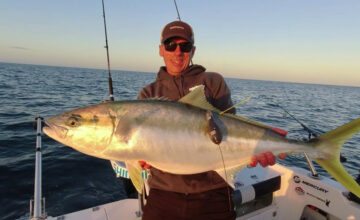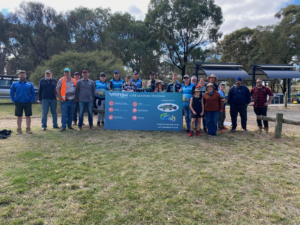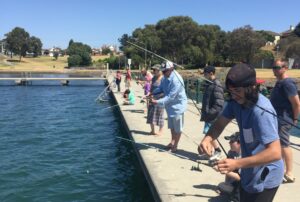June 24, 2017
Written by Professor Gregory Jenkins, University of Melbourne
One of the unanswered questions about the life cycle of King George whiting is where fish from Victorian waters spawn. Research over the past 30 years has found little evidence of spawning in, or near, the main bays (Port Phillip, Western Port or Corner Inlet).
Most fish in the bays are juveniles, up to four years of age, while adults in the known spawning areas of South Australia (SA) and Tasmania can be up to 20 years old.
Recent research has also shown that older Victorian whiting are not migrating to the known SA (north of Kangaroo Island) or Tasmania (north-west coast) spawning areas. Scientists believe the most likely spawning area for Victorian whiting is along the coast west of Portland into south-eastern SA. To confirm this, Melbourne University scientists are collaborating with recreational fishers to tag whiting as part of a new three year grant project from the recreational fishing licence funding program.
The project has been underway since the start of the year and tagging kits, including about 2000 tags, have been distributed to fishers from nine Victorian fishing clubs.Tagging, so far, has been focussed around Port Phillip Bay and Western Port. Some anglers have already managed to tag 30 to 40 whiting, with many larger fish around the 40 centimetre mark. These larger whiting are likely to be four years old and would be expected to move out of the bays during the next six months, or so, and start migrating along the coast.

Remarkably, there has already been six recaptures of tagged whiting, with times from tagging, to recapture, ranging from 45 minutes to three months! So far recaptures have been close to the tagging location, even after a few months, indicating that fish tend to stay in the same area. The high recapture rate gives us confidence that the tags aren’t affecting the health of the fish and also that the tags are not being shed.
Fishers are asked to look out for the yellow tags when they are catching whiting. Each tag has a unique number, as well as a phone number (03) 5258 3686 and E: ([email protected]) to report the recapture. Fishers are asked to measure the recaptured fish (fork length or total length) as well as the date and location of capture. If possible, it would be good if tagged whiting could be re-released after the information is recorded so that they might continue to provide information into the future!
Scientists are expecting that as tagged fish grow and leave the bays, recaptures may start to be reported from the coast, providing information on potential spawning areas. A dedicated web-page has been developed tracking the progress of the project and detailing the movement results as they come in, visit the project blog page..
The results of the project will contribute greatly to the understanding of the biology and life history of King George whiting and, potentially for the first time, confirm the spawning area for Victorian whiting. This will help give a more complete understanding of the life cycle of this iconic species.







